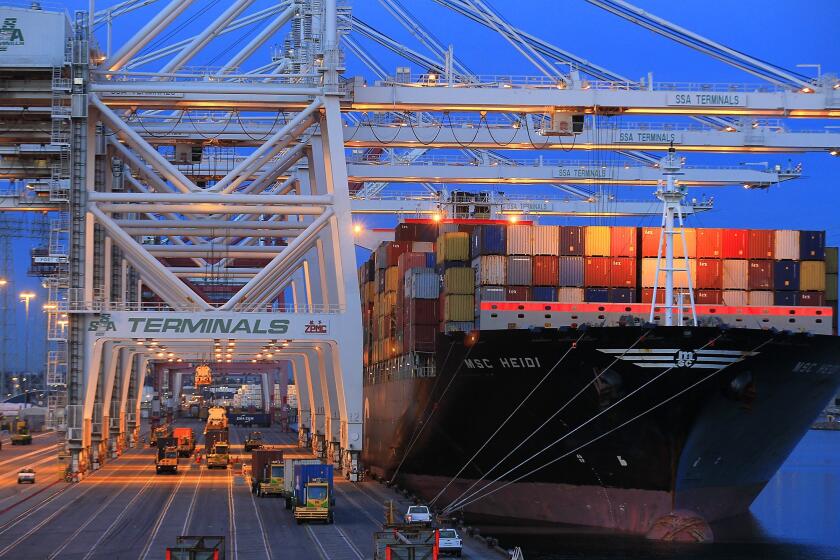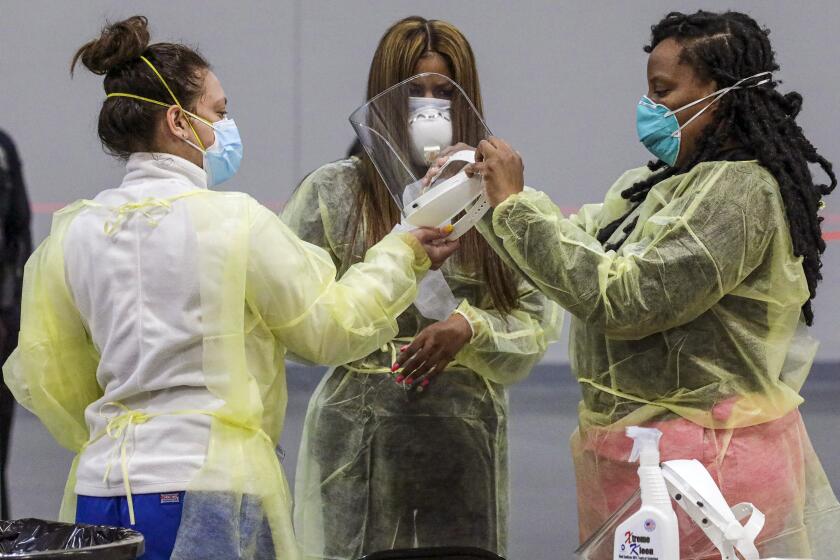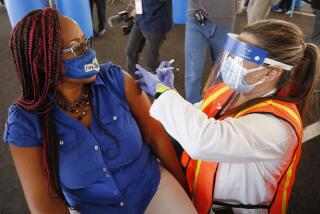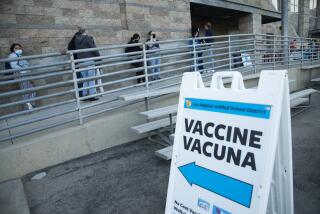Who’s ‘essential’? COVID-19 vaccine rollout leaves high-risk workers behind
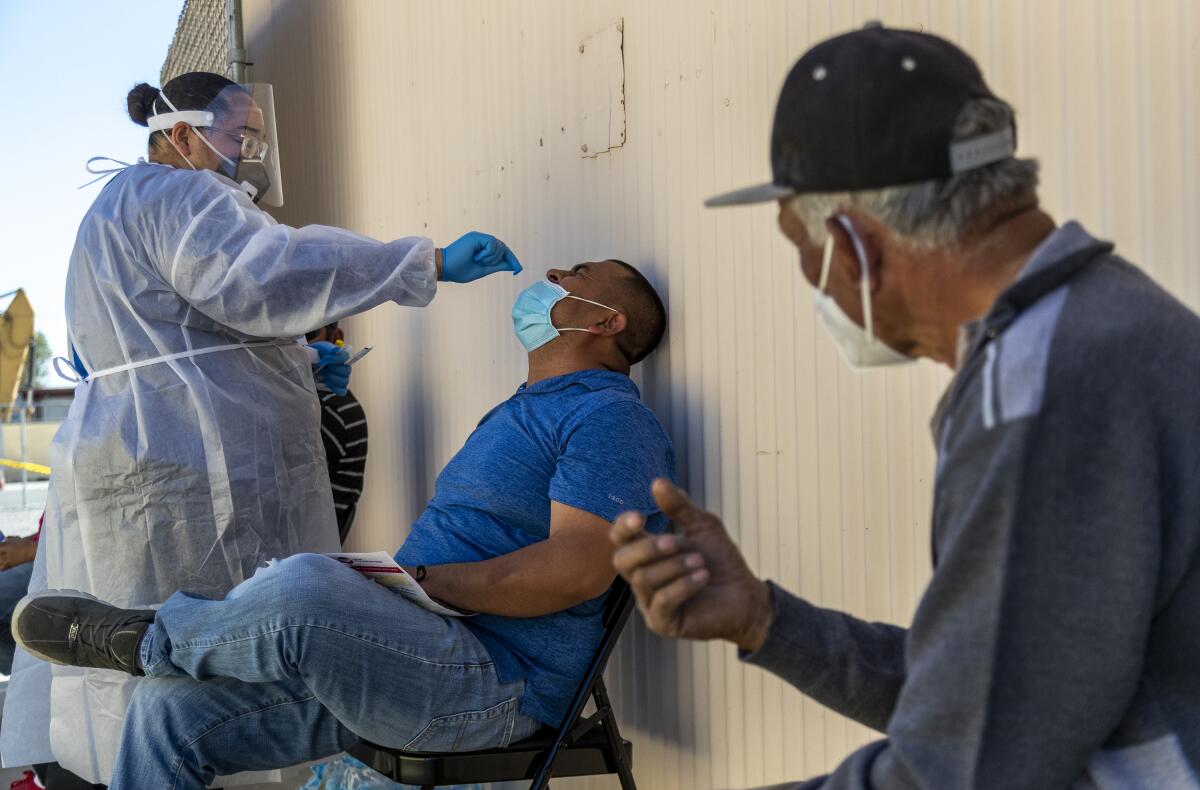
Millions of front-line workers in California are falling through the cracks of an undersupplied COVID-19 vaccine distribution system, putting entire communities at prolonged risk of illness and raising the question among workers: Who counts as “essential,” and who gets to decide?
The state’s front-line workforce includes 5.7 million people at heightened risk during the pandemic, according to the California Legislative Analyst’s Office. They package food, prune fields, clean offices and assemble cloth face masks, among other jobs.
Some have higher-paid roles in public health and public corrections. All are at risk of contracting the virus because they regularly interact with other people — customers and colleagues — as they keep services running and pantries stocked.
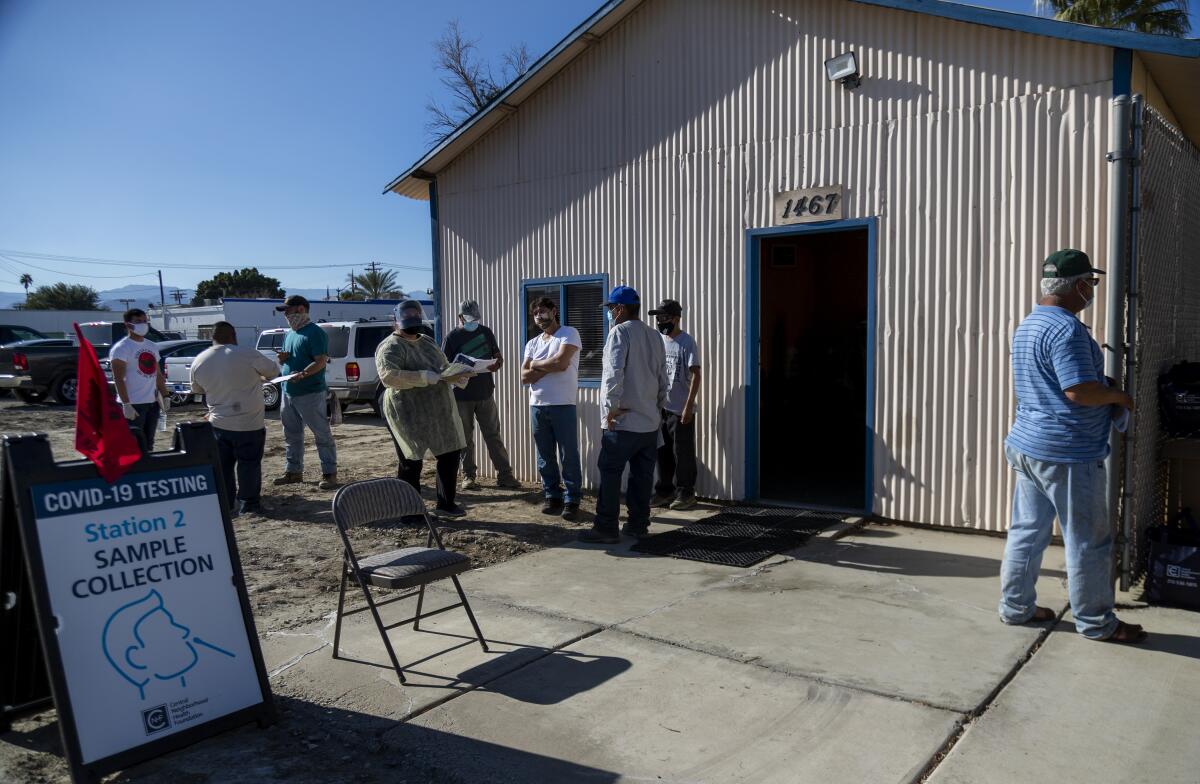
“People don’t realize we have been exposed and are still being exposed. We need the vaccine,” said Santiago Puac, 42, a worker at a clothing factory in downtown Los Angeles. Puac said he got sick in August but didn’t take a coronavirus test, and kept going to work, because he couldn’t afford to stay home.
His body ached and he lost his sense of smell. At night, he locked himself in a room to try to isolate from his wife and children. Come morning, he headed to the building at 21st Street and Broadway where he sews blouses and other women’s clothing every day, packing in with 100 workers from three garment manufacturers.
In its formal planning, the state has prioritized some essential workers for vaccines. The current vaccination Phase 1B, which includes people 65 and older and essential workers in education and emergency services, also lists workers in food and agriculture as eligible for shots. In Los Angeles County, food and agriculture workers are now part of a group of essential workers in the county who will be eligible to get vaccinated starting March 1.
But a severe undersupply of doses statewide, as well as the tiered system that has shifted to focus on the top age group, has muddied efforts to inoculate high-risk workers at farms, restaurants and grocery stores. Revisions to the state’s rollout plan and what critics call confusing messaging have also cast a shadow over millions of workers who don’t feature in priority vaccination groups.
Transportation and logistics workers, previously set to receive inoculations under the second tier of Phase 1B, won’t be eligible for early vaccines as the state pursues its age-based strategy. Other workers, such as those in the construction and garment industries, have not been identified in priority groups even as they continue to work in perilous conditions.
That is tantamount to “being denied priority access to the vaccine,” said Tim Shadix, legal director of the Warehouse Workers Resource Center. “This is not the equity the governor promised, and it is dangerous to deprioritize vaccination at workplaces where COVID-19 exposure has been severe.”
The outcome has been clear. COVID-19 has ripped through low-income communities, spreading in crowded households where wage earners bring the virus from, or take it to, work. Many do not have the financial safety net to stay home and quarantine when infected or exposed. Latinos, in particular, are dying in their prime years — their 40s and 50s — worker advocates said.
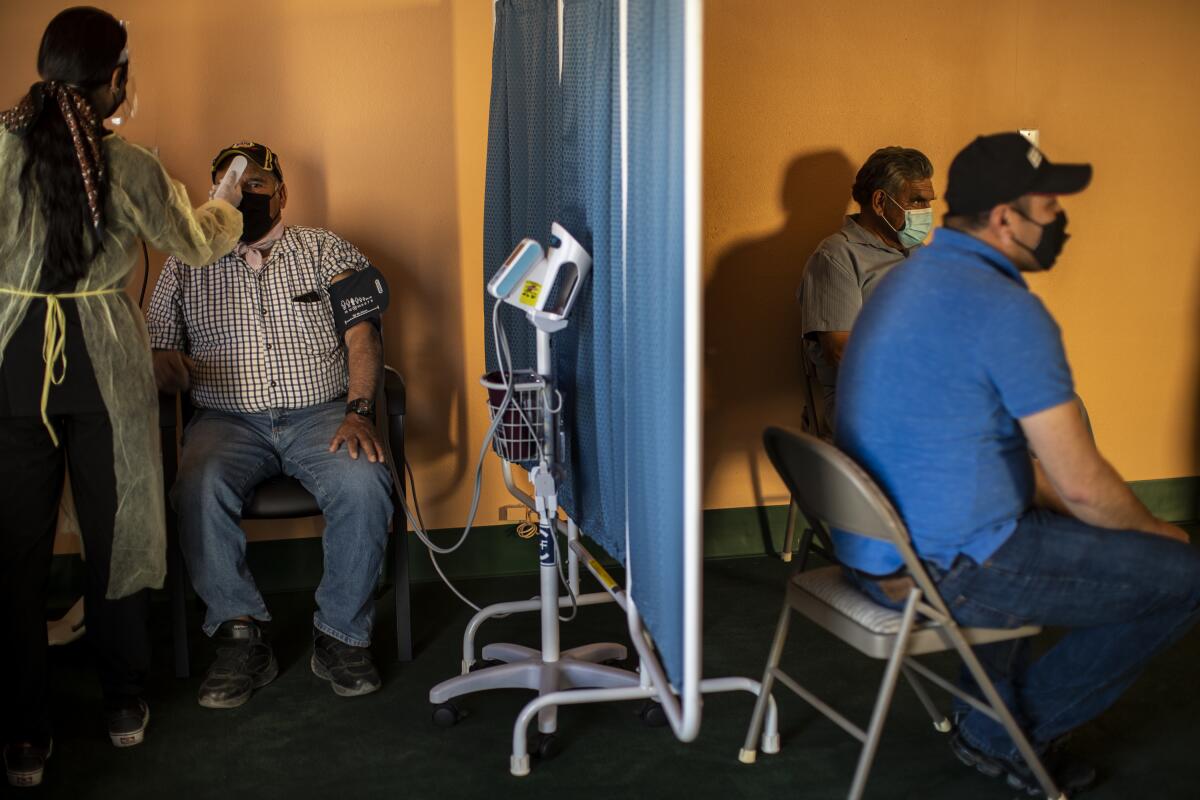
Nationally, 13 states have prioritized vaccine access for food sector workers, a low number that means many lives remain at risk, according to United Food and Commercial Workers International, the nation’s largest union. It represents 1.3 million food workers including in retail, meatpacking and processing. The union says it has tracked 80,000 coronavirus infections and 400 deaths among members.
In California, Gov. Gavin Newsom said last week that the state continued to refine its distribution plans “to make sure that we have equity front and center.” Some experts say a shift to prioritizing older populations is a more efficient way to administer vaccines than trying to parse the various groups of essential workers. Dr. David Eisenman, director of the Center for Public Health and Disasters at the UCLA Fielding School of Public Health, said it was necessary to help reduce the strain on hospitals quickly.
On Wednesday, Newsom visited a farmworker vaccination site in Riverside County, which he praised as the first county in the state to launch clinics specifically for farmworkers, beginning mid-January.
“You’ve got to meet people where they are, and that’s exactly what folks are doing here on the ground,” he said at the start of a three-day vaccination drive at SeaView Packing, a company in Coachella that supplies and packs medjool dates and other fruits.
“I’m just here with that respect, that recognition and that understanding that we need to replicate that program all up and down the state of California,” the governor said.
A Covid-19 surge at the ports of Los Angeles and Long Beach has sickened hundreds of longshore workers, a disruption that could stymie the flow of goods - including pandemic supplies - through the nation’s largest port complex. Port and local officials are calling for urgent vaccination of dockworkers.
Healthcare workers, residents of long-term care facilities and people 65 and over make up the largest portion of those who have received a first vaccine dose, according to data from the California Department of Public Health. The state is expanding access to an estimated 4 million to 6 million people with disabilities or severe underlying health conditions starting in mid-March.
“Vaccine distribution should prioritize workers with higher mortality rates,” said Diana Tellefson Torres, executive director of the United Farm Workers Foundation, an advocacy group. “We can’t ignore those who are most vulnerable, who live in rural areas, who are doing the essential work of feeding this nation.”
It’s not just a rural problem. Across Los Angeles, garment workers sit side by side in factories, many without windows, for 10- to 12-hour days. The crowded shops are rife with virus transmission, said Marissa Nuncio, director of downtown L.A.’s Garment Worker Center.
Over the summer, authorities temporarily shut down the Los Angeles Apparel factory in South Los Angeles after an investigation found more than 300 coronavirus infections and four deaths among workers.
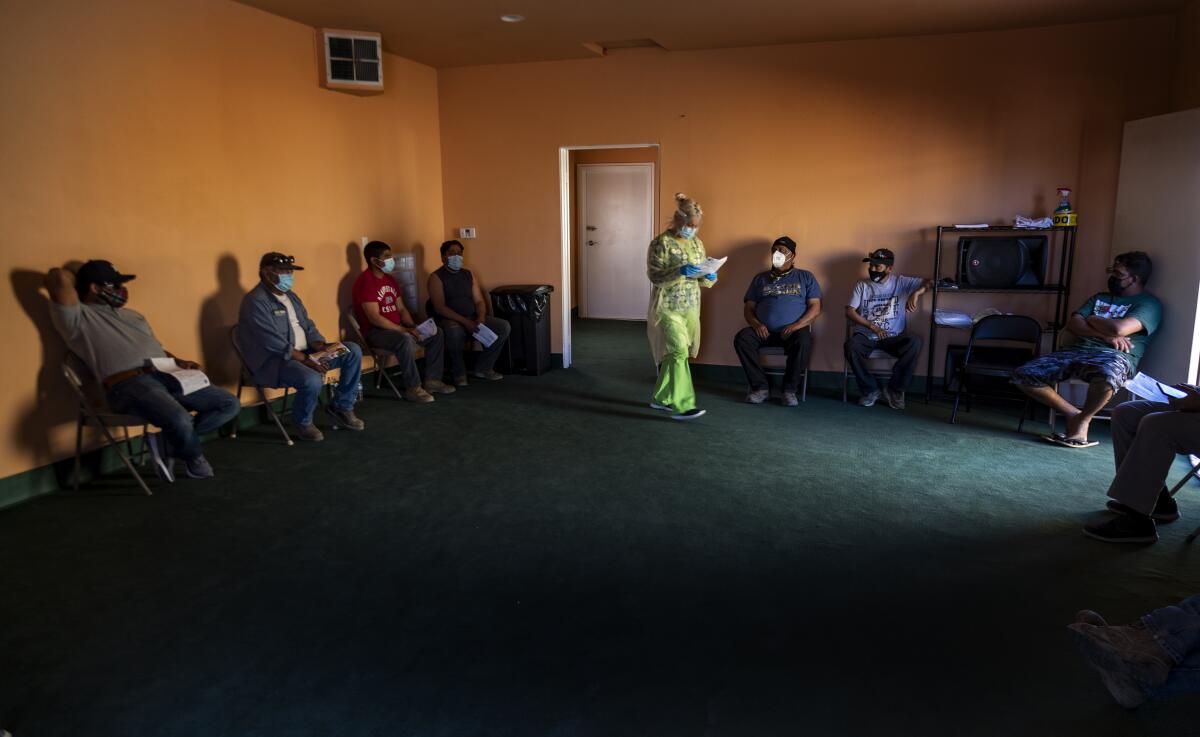
Nuncio said the center has reached out to public agencies including the Los Angeles County and California health departments to ask about vaccinations for garment workers, who don’t clearly fit under the category of “critical manufacturing” essential workers defined by the state.
“We have not gotten a yes or a no that this group will be prioritized. We just haven’t received any direct response,” she said.
Puac, the worker who got sick in the fall, said his boss didn’t take the virus seriously for a long time. Workers at his factory were crowded together without masks until October, when county health inspectors visited the site.
The workplace feels slightly safer now, with about six feet of space between sewing stations, he said. He still suspects some of his co-workers are doing what he did: coming to work sick. “I haven’t heard anything about garment workers, and that really worries me,” he said of getting the vaccine.
A UC San Francisco study that measured increases in deaths among some population groups during the pandemic found a very high risk of death in essential-work sectors, including food and agriculture, manufacturing, transportation and logistics.
Food and agriculture workers were found to have a 39% increase in mortality, the highest among the groups studied. Among Latino food and agriculture workers, the study found a 59% increase in mortality.
Kirsten Bibbins-Domingo, a UCSF professor who co-wrote the study, said she is concerned the current pace of the state’s vaccine rollout will take too long to get to essential workers: “We need to make sure we don’t wait to get through every single 65-year-old before moving on to people working in jobs that place them at higher risk.”
“It’s not about pitting those 65 and older over farmworkers,” said Tellefson Torres, the farmworker advocate. “But why say they’re in the same priority tier if they’re not truly in the same priority tier?”
Who gets California’s COVID-19 vaccine? A ‘Sophie’s Choice’ moment for many in need.
For those facing the virus at work daily, it’s a race against time.
Kathleen Scott, 55, said she and co-workers at the Los Feliz supermarket where she works as a checker confirmed with their union in early January that they would soon be eligible for the vaccine. It felt as though she’d been thrown a life raft, but the weeks have dragged on, and still no vaccine.
The stress of every little interaction — a customer picking his nose, people walking through the store with their masks sliding off — is cumulative, Scott said. Back in the spring, she might have been able to laugh it off. “But now in February, we’re locking ourselves in the bathroom and crying,” she said.
Ronald Fong, president of the California Grocers Assn., said grocery and other food workers remain “locked in” a high-priority spot for the vaccine. He didn’t elaborate on how that would work in practice as the state shifted to an age-based system. Fong sits on the state’s vaccine task force.
Targeted efforts in some pockets of California have gotten a few thousand farm and food workers vaccinated. Long Beach has vaccinated just over 1,000 of its estimated 2,500 food sector workers since it opened up the shots to them on Jan. 19, the city’s Health Department said.
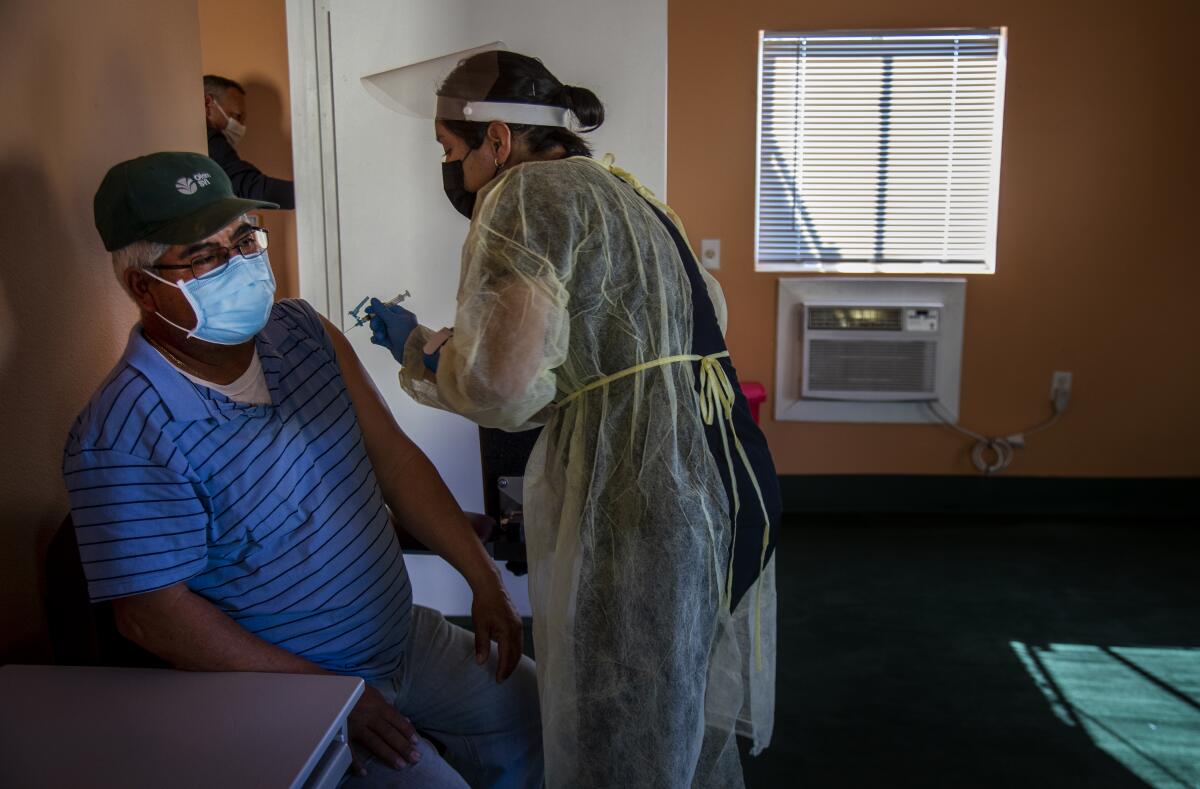
Pilot programs and vaccination clinics in Riverside, Santa Cruz, Ventura and Fresno counties have also focused on agriculture workers. Few other local governments have announced plans to begin inoculating their high-risk food workers.
A group of medical students who administer flu vaccines to agriculture workers in Northern California, known as the “Stanford flu crew,” has long-standing partnerships with farms and is ready to mobilize, said Dr. Walter Newman, a family physician in San Jose who oversees the initiative.
Newman said he requested supplies from Monterey and Santa Clara county officials to administer vaccines at farms for workers 65 and older. He said the counties declined to allocate doses.
Monterey County later announced that food and agricultural workers ages 65 to 74 will be eligible to schedule vaccine appointments beginning Wednesday. A Santa Clara County spokesperson said the Public Health Department is in discussions with Newman on how his group can assist vaccination efforts. Because it’s not a state-registered vaccine provider, “the county cannot allocate vaccine directly to them.”
The Central Neighborhood Health Foundation, a network of federally qualified health centers in Los Angeles County and the Inland Empire, dedicated 50 of 100 Moderna vaccine doses it received last week from Riverside County for farmworkers in the Coachella Valley. The vaccine drive there had to turn some people away, Chief Operating Officer Eleanor Perez said.
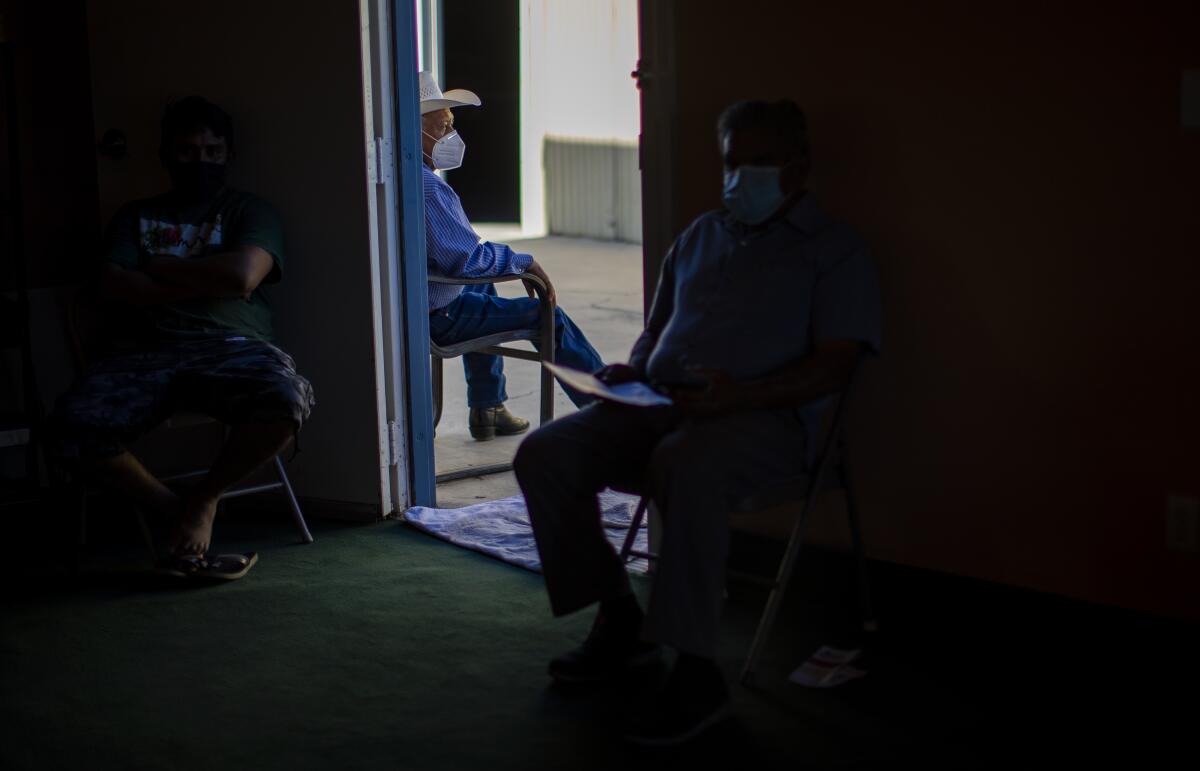
Perez said the supply is far from consistent enough to serve the foundation’s 25,000 mostly low-income patients, many of whom are uninsured. Similar clinics in other communities hard hit by COVID-19 have reported difficulty obtaining vaccine doses.
Outreach and education to tackle language and digital barriers are other hurdles. The United Farm Workers Foundation, which helped run the Coachella vaccine drive, is rolling out public service announcements on social media and through its partnered radio station on the importance of getting vaccinated.
In a survey of more than 10,000 agriculture workers conducted by the foundation via text message, nearly 96% said they felt neutral, agreeable or very agreeable to getting the vaccine as soon as it becomes available to them.
Among the lucky 50 in Coachella was Antonio Chavez Serrano, 63. He and other workers lined up first for a rapid coronavirus test and, upon getting a negative result, filled out a vaccine consent form and waited in a small corrugated metal building.
Serrano, who works at a date orchard, said he thought of a co-worker as he got his first vaccine dose. The man in his 50s had died from COVID-19 complications and been buried the previous day. That same day, Serrano had driven to the vaccine clinic to make sure he knew the route.
He wanted to leave no chance for error: “We couldn’t wait for it to be our turn.”
The moment was bittersweet too for Jesus Alvarez, 72. Except to work pruning an orchard, Alvarez said, he never leaves the home where he lives with his daughter and grandchildren. “Thank God,” he said, shot in arm, vaccination record in hand.
“I’ll feel better when everyone gets vaccinated,” he said. “Such scarcity and so many people who need it.”
More to Read
Inside the business of entertainment
The Wide Shot brings you news, analysis and insights on everything from streaming wars to production — and what it all means for the future.
You may occasionally receive promotional content from the Los Angeles Times.
